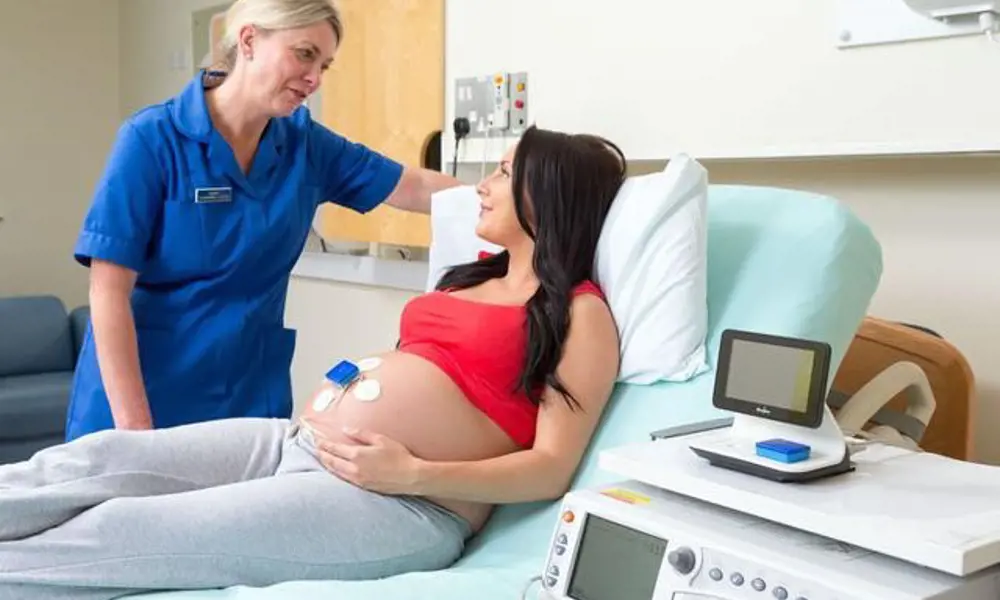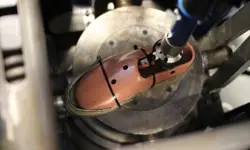
Wireless foetal monitor
The monitoring of foetal heart rate and contraction during pregnancy and labour has been clinical practice over the last 40 years – helping evaluate the wellbeing of the unborn baby and mother. Two belts wrapped around the mother’s abdomen have been used to hold separate transducers connected to a bedside monitor called a cardiotocograph (CTG). Now, a team of engineers and healthcare experts have invented a wireless waterproof patch system that reliably and accurately measures a baby’s heartbeat without belts.
The Monica wireless patch is a single-use, peel-and-stick disposable item that attaches to the woman’s abdomen using adhesives. The patch incorporates electrocardiogram (ECG) electrode areas that pick up ECG and electromyogram (EMG) signals from the skin surface and passes them to the Monica Pod. The reusable pod magnetically connects to the patch to gather both the foetal and maternal ECG and EMG signals. This small electronic pod then filters, digitises and processes these signals to extract, in real time, the foetal and maternal heart rate, plus uterine activity (contractions) data. The pod wirelessly transmits this data to a bedside interface monitor directly connected to an installed base CTG machine, enhancing the efficiency of valuable hospital resources.
Before achieving European CE approval and US Food and Drug Administration approval in 2011, the device had to demonstrate over 90% success rate. It did this and succeeded in achieving just 0.4% foetal/maternal heart rate confusion compared with 10% of its nearest competitor. Previously, the need to frequently move the transducer belts to capture the heartbeats had taken a medic’s time away from focusing on the mother-to-be. The innovative patch means that there is no need to reposition the device.
the device had to demonstrate over 90% success rate. It did this and succeeded in achieving just 0.4% foetal/maternal heart rate confusion compared with 10% of its nearest competitor
Research on this innovation started in the 1990s within the Department of Electrical and Electronic Engineering at the University of Nottingham. Electronics engineer Professor Barrie Hayes-Gill and biomedical engineer Professor John Crowe recognised the signature differences between the foetal and maternal ECG as a way of separating the two intertwined signals. However, because the foetal ECG was so small, the electronic noise on the mother’s abdomen interfered significantly with the signal. The team worked to reduce the noise and eventually increased the visibility of the many foetal ECG complexes. They then created a three-channel abdominal system, which ensures that if the foetus moves out of range of one channel, it falls into the range of another. These features were subsequently combined into four international patents.
In 2005, Professor Hayes-Gill formed Monica Healthcare, a university spin-out, with electronic engineering colleagues, Dr Carl Barratt and Dr Jean Francois Pieri, along with mechanical engineer, Dr Terence Martin. With £500,000 of venture capital funding, Monica Healthcare worked to file a further eight patents and published work indicating significant improvements over the belt-based systems. In 2017, the company was sold to GE Healthcare – its North American distribution partner – which has led to the product, now called the Monica wireless patch®, being available to millions worldwide.
The patch allows mothers to move around freely while being monitored, which can help to shorten labour, reduce interventions and help the birthing experience
The patch allows mothers to move around freely while being monitored, which can help to shorten labour, reduce interventions and help the birthing experience. The device overcomes heart-rate confusion between mother and unborn child and is unaffected by high body mass index, unlike the traditional belt ultrasound method.
The Monica device has won many obstetric and engineering awards. The latest engineering award came in November 2019, when the Royal Academy of Engineering awarded the team with the Colin Campbell Mitchell Award.
***
This article has been adapted from "Wireless foetal monitor", which originally appeared in the print edition of Ingenia 82 (March 2020).
Keep up-to-date with Ingenia for free
SubscribeRelated content
Health & medical

Kidney dialysis
Small haemodialysis machines have been developed that will allow more people to treat themselves at home. The SC+ system that has been developed is lighter, smaller and easier to use than existing machines.

Engineering polymath wins major award
The 2015 Queen Elizabeth Prize for Engineering has been awarded to the ground-breaking chemical engineer Dr Robert Langer FREng for his revolutionary advances and leadership in engineering at the interface between chemistry and medicine.

Blast mitigation and injury treatment
The Royal British Legion Centre for Blast Injury Studies is a world-renowned research facility based at Imperial College London. Its director, Professor Anthony Bull FREng, explains how a multidisciplinary team is helping protect, treat and rehabilitate people who are exposed to explosive forces.

Targeting cancers with magnetism
Cambridge-based Endomag has helped treat more than 6,000 breast cancer patients across 20 countries. The MacRobert finalist uses magnetic fields to power diagnostic and therapeutic devices. Find about the challenges that surround the development and acceptance of medical innovations.
Other content from Ingenia
Quick read

- Environment & sustainability
- Opinion
A young engineer’s perspective on the good, the bad and the ugly of COP27

- Environment & sustainability
- Issue 95
How do we pay for net zero technologies?
Quick read

- Transport
- Mechanical
- How I got here
Electrifying trains and STEMAZING outreach

- Civil & structural
- Environment & sustainability
- Issue 95